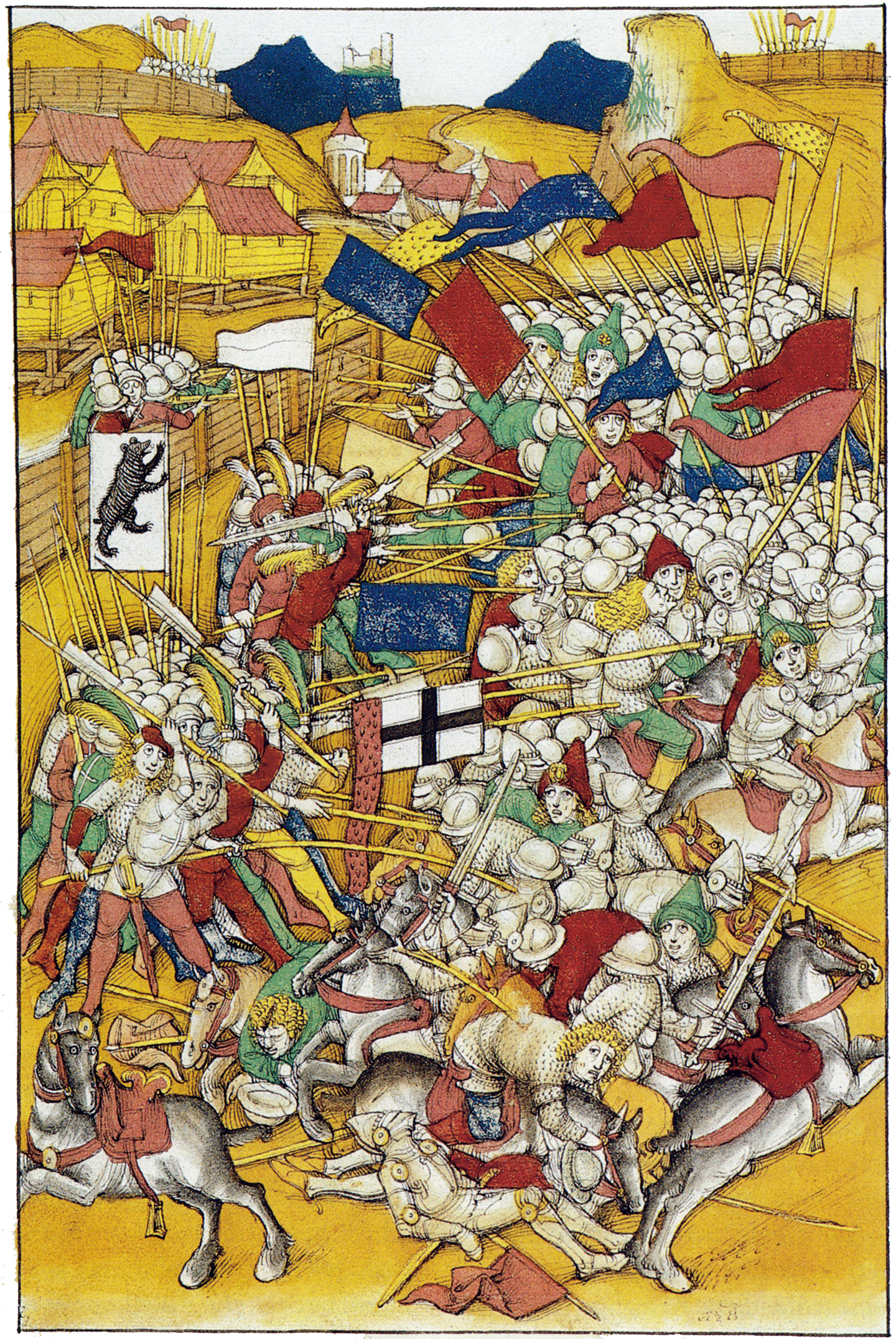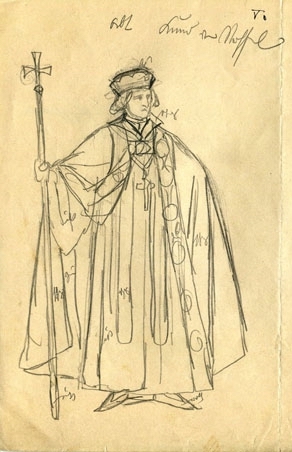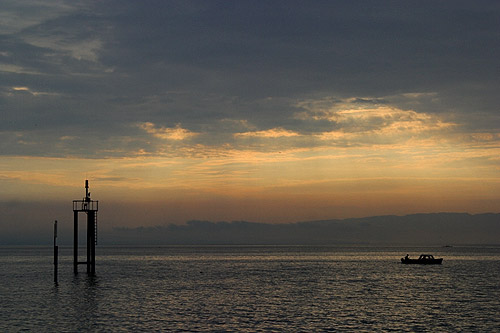|
Appenzell War
The Appenzell Wars (german: Appenzeller Kriege) were a series of conflicts that lasted from 1401 until 1429 in the Appenzell region of modern-day Switzerland. The wars consisted of uprisings of cooperative groups, such as the farmers of Appenzell or the craftsmen of the city of St. Gallen, against the traditional medieval power structure represented by the House of Habsburg and the Prince-Abbot of the Abbey of St. Gall. The conflict was one of a number of popular revolts in late-medieval Europe. It resulted in greater autonomy for Appenzell and its association with the Old Swiss Confederacy, of which it would become a member ( canton) in 1513. Background Appenzell (the name in la, abbatis cella means "cell (i.e. estate) of the abbot") had been under the personal control of the abbot of St. Gall. While the Prince-Abbot appointed agents or bailiffs, the communities in Appenzell were governed by a council appointed by the ''Landsgemeinde'', in which every citizen could vote. The ... [...More Info...] [...Related Items...] OR: [Wikipedia] [Google] [Baidu] |
Schilling Schlacht Bei Voeglinsegg 1403
{{disambiguation ...
Schilling may refer to: * Schilling (unit), an historical unit of measurement * Schilling (coin), the historical European coin * Austrian schilling, the former currency of Austria * A. Schilling & Company, an historical West Coast spice firm acquired in 1948 by McCormick & Company * Schilling Air Force Base * Schilling Power Station, an oil-fired power station near the nuclear power station at Stade, Germany * Schilling of Solothurn, a family of two Swiss chroniclers * The Schilling School for Gifted Children, a K-12 school in Cincinnati, Ohio People * Schilling (surname) See also * Schilling test in medicine * Shilling * Schillings, a firm of UK lawyers * Schillings (surname) * Skilling (currency) The skilling (pronounced ''shilling'' in English) was the Scandinavian equivalent of the shilling. It was used as a subdivision of the various kinds of currencies named rigsdaler in use throughout Scandinavia, including the Danish rigsdaler, the ... [...More Info...] [...Related Items...] OR: [Wikipedia] [Google] [Baidu] |
Kuno Von Stoffeln
Kuno von Stoffeln (born before 1365; died 19 October 1411) was from 1379 until his death Prince abbot of Saint Gall. He descended from the family von Stoffeln with property on Castle Hohenstoffeln on the Hohenstoffeln at Hegau. He was substantially involved in the Appenzell Wars as the city refused to pay homage to him, and the Appenzellers, his subjects, even refused to pay taxes. Due to the price decline of grain after a disastrous plague epidemic, Kuno had been obliged to drastically increase taxes in order to balance the loss of revenue. He first aligned with cities at Lake Constance that were devoted to him and later with Duke Frederick IV of Austria Frederick IV (1382 – 24 June 1439), also known as Frederick of the Empty Pockets (german: Friedrich mit der leeren Tasche), a member of the House of Habsburg, was Duke of Austria from 1402 until his death. As a scion of the Habsburg Leopoldian ... in order to put an end to the population's attempts at freedom. He was not gr ... [...More Info...] [...Related Items...] OR: [Wikipedia] [Google] [Baidu] |
Frederick IV, Duke Of Austria
Frederick IV (1382 – 24 June 1439), also known as Frederick of the Empty Pockets (german: Friedrich mit der leeren Tasche), a member of the House of Habsburg, was Duke of Austria from 1402 until his death. As a scion of the Habsburg Leopoldian line, he ruled over Further Austria and the County of Tyrol from 1406 onwards. Biography Frederick was the youngest son of Duke Leopold III (1351–1386) and his wife Viridis (d. 1414), a daughter of Bernabò Visconti, Lord of Milan. According to the 1379 Treaty of Neuberg, his father ruled over the Habsburg Inner Austrian territories of Styria, Carinthia, Carniola, as well as over Tyrol and the dynasty's original Further Austrian possessions in Swabia. After the early death of Duke Leopold in the 1386 Battle of Sempach, Frederick and his elder brothers William, Leopold IV and Ernest initially remained under the tutelage of their uncle Duke Albert III of Austria. As an inheritance dispute arose upon Duke Albert's death in 1395, the you ... [...More Info...] [...Related Items...] OR: [Wikipedia] [Google] [Baidu] |
Lake Constance
Lake Constance (german: Bodensee, ) refers to three Body of water, bodies of water on the Rhine at the northern foot of the Alps: Upper Lake Constance (''Obersee''), Lower Lake Constance (''Untersee''), and a connecting stretch of the Rhine, called the Seerhein, Lake Rhine (''Seerhein''). These waterbodies lie within the Lake Constance Basin () in the Alpine Foreland through which the Rhine flows. The lake is situated where Germany, Switzerland, and Austria meet. Its shorelines lie in the German states of Baden-Württemberg and Bavaria, the Swiss cantons of Canton of St. Gallen, St. Gallen, Canton of Thurgau, Thurgau, and Canton of Schaffhausen, Schaffhausen, and the Austrian state of Vorarlberg. The actual location of the border Lake_Constance#International_borders, is disputed. The Alpine Rhine forms in its original course the Austro-Swiss border and flows into the lake from the south. The High Rhine flows westbound out of the lake and forms (with the exception of the Canton ... [...More Info...] [...Related Items...] OR: [Wikipedia] [Google] [Baidu] |
Alpine Rhine Valley
The Alpine Rhine Valley (german: Alpenrheintal) is a glacial alpine valley, formed by the part of the Alpine Rhine (german: Alpenrhein ) between the confluence of the Anterior Rhine and Posterior Rhine at Reichenau and the Alpine Rhine's mouth at Lake Constance. It covers three countries and the full length of the Alpine Rhine is 93.5 km. From Reichenau, the Alpine Rhine flows east, passing Chur and turning north, before it turns north-east at Landquart, and then roughly north, east of Sargans. From here, the Alpine Rhine forms the border between the canton of St. Gallen of Switzerland on the left, west side, and the Principality of Liechtenstein on the east side. About further down, the Rhine then meets the Austrian federal state Vorarlberg and finally flows into Lake Constance, south of Lindau (Germany), which is no longer part of the Rhine Valley. The Swiss-Austrian border follows the historical bed of the Rhine, but today the river follows an artificial canal within Aus ... [...More Info...] [...Related Items...] OR: [Wikipedia] [Google] [Baidu] |
Arbon
, neighboring_municipalities= Egnach, Roggwil TG, Berg SG, Steinach, Horn , twintowns = Langenargen (Germany), Binn (Switzerland) Arbon is a historic town and a municipality and district capital of the district of Arbon in the canton of Thurgau in Switzerland. Arbon is located on the southern shore of Lake Constance, on a railway line between Konstanz/Romanshorn and Rorschach/Chur, or St. Gallen, respectively. It is the site of prehistoric settlements reaching back 6500 years. Elements of the castle on the peninsula were part of a Late Roman defensive fortification that developed into a medieval town in the first half of the thirteenth century. The official language of Arbon is (the Swiss variety of Standard) German, but the main spoken language is the local variant of the Alemannic Swiss German dialect. Geography Arbon is situated on a peninsula on the southwest shore of Lake Constance between Romanshorn and Rorschach. On the south, the municipality borders the ca ... [...More Info...] [...Related Items...] OR: [Wikipedia] [Google] [Baidu] |
Armistice
An armistice is a formal agreement of warring parties to stop fighting. It is not necessarily the end of a war, as it may constitute only a cessation of hostilities while an attempt is made to negotiate a lasting peace. It is derived from the Latin ''arma'', meaning "arms" (as in weapons) and ''-stitium'', meaning "a stopping". The United Nations Security Council often imposes, or tries to impose, cease-fire resolutions on parties in modern conflicts. Armistices are always negotiated between the parties themselves and are thus generally seen as more binding than non-mandatory UN cease-fire resolutions in modern international law. An armistice is a '' modus vivendi'' and is not the same as a peace treaty, which may take months or even years to agree on. The 1953 Korean War Armistice Agreement is a major example of an armistice which has not been followed by a peace treaty. An armistice is also different from a truce or ceasefire, which refer to a temporary cessation of hostiliti ... [...More Info...] [...Related Items...] OR: [Wikipedia] [Google] [Baidu] |
Infantry
Infantry is a military specialization which engages in ground combat on foot. Infantry generally consists of light infantry, mountain infantry, motorized infantry & mechanized infantry, airborne infantry, air assault infantry, and marine infantry. Although disused in modern times, heavy infantry also commonly made up the bulk of many historic armies. Infantry, cavalry, and artillery have traditionally made up the core of the combat arms professions of various armies, with the infantry almost always comprising the largest portion of these forces. Etymology and terminology In English, use of the term ''infantry'' began about the 1570s, describing soldiers who march and fight on foot. The word derives from Middle French ''infanterie'', from older Italian (also Spanish) ''infanteria'' (foot soldiers too inexperienced for cavalry), from Latin '' īnfāns'' (without speech, newborn, foolish), from which English also gets '' infant''. The individual-soldier term ''infantry ... [...More Info...] [...Related Items...] OR: [Wikipedia] [Google] [Baidu] |
Cavalry
Historically, cavalry (from the French word ''cavalerie'', itself derived from "cheval" meaning "horse") are soldiers or warriors who fight mounted on horseback. Cavalry were the most mobile of the combat arms, operating as light cavalry in the roles of reconnaissance, screening, and skirmishing in many armies, or as heavy cavalry for decisive shock attacks in other armies. An individual soldier in the cavalry is known by a number of designations depending on era and tactics, such as cavalryman, horseman, trooper, cataphract, knight, hussar, uhlan, mamluk, cuirassier, lancer, dragoon, or horse archer. The designation of ''cavalry'' was not usually given to any military forces that used other animals for mounts, such as camels or elephants. Infantry who moved on horseback, but dismounted to fight on foot, were known in the early 17th to the early 18th century as '' dragoons'', a class of mounted infantry which in most armies later evolved into standard cavalry while ... [...More Info...] [...Related Items...] OR: [Wikipedia] [Google] [Baidu] |
Speicher, Switzerland
Speicher is a municipality in the canton of Appenzell Ausserrhoden, in Switzerland. History Speicher is first mentioned in 1309 as ''Spicher''. The name originated in the Middle Ages, during the heyday of the Abbey of Saint Gall. At that time the village church served as a granary of the monastery. The first battle of the Appenzell Wars was fought at the village of Vögelinsegg, near Speicher in 1403. A monument to the battle, a pointing Appenzell farmer with a morning star, was built in 1903 on the ridge of Vögelinsegg. A right of way had to be blasted through the rock at Vögelinsegg to lay the track for the ''Trogenerbahn'' in 1900. Geography Speicher has an area, , of . Of this area, 54.8% is used for agricultural purposes, while 28.6% is forested. Of the rest of the land, 16.1% is settled (buildings or roads) and the remainder (0.5%) is non-productive (rivers, glaciers or mountains). The municipality is located in the former District of Mittelland. Until the 195 ... [...More Info...] [...Related Items...] OR: [Wikipedia] [Google] [Baidu] |
Trogen, Switzerland
Trogen is a municipality in the canton of Appenzell Ausserrhoden in Switzerland. The town is the seat of the canton's judicial authorities. History The first mentioning of Trogen was in 1168 (''Trugin''). The name Trogen refers to a number of fountains (''Trögen'') which is reflected in the coat of arms. In the 18th century the village was dominated by the local Zellweger family which enjoyed success with textile production and trade. The family established the grammar school (''Kantonsschule'') in 1821. Geography Trogen has an area, , of . Of this area, 50.9% is used for agricultural purposes, while 41.1% is forested. Of the rest of the land, 7.8% is settled (buildings or roads) and the remainder (0.2%) is non-productive (rivers, glaciers or mountains). Demographics Trogen has a population () of 1,688, of which about 7.7% are foreign nationals. [...More Info...] [...Related Items...] OR: [Wikipedia] [Google] [Baidu] |






.jpg)



